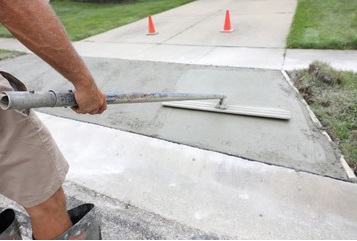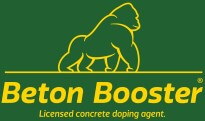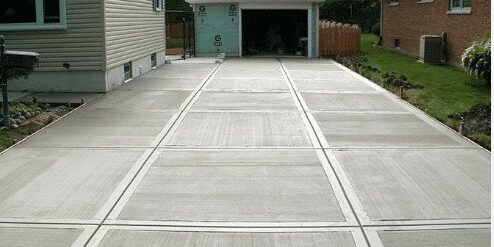Determining the thickness of the driveway concrete is important not only because of the scale of work ahead but also for your wallet’s sake.
If we construct a structure that is not thick enough, the risk of damage after use significantly increases, and repairs often require complete demolition and re-concreting.
On the other hand, if we construct a structure that is unreasonably thick, the material and labor costs will be unnecessarily high.
Therefore, the thickness of the driveway concrete and the layer beneath it are essential considerations before starting the work.
Before planning, it is crucial to determine the soil’s stability where you intend to carry out the concreting. Do not plan a driveway on expansive clay or soft, uncertain, or waterlogged soil because it will have a short lifespan. Just like a chain is only as strong as its weakest link, building very thick and robust concrete on such soil will eventually fail.
If the soil is suitable for the concrete structure, the next step is to assess the expected loads from vehicles and their frequency.

I often encounter two extreme attitudes:
- “Just pour 10 cm, and it’ll be fine. I’ve done it before, added some reinforcement, and it’s been running with combines for 10 years. No issues!”
- “A Suzuki will be parked on it, but we only use it once a week. That’s why I thought of a 20 cm driveway concrete thickness with a layer of 10 cm reinforced with steel mesh, and below that, 25 cm of gravel.”
The problem with the first approach is that there may be a rare set of circumstances where such a structure works, but the chances are slim.
With the second approach, it’s true that combines can indeed drive on it, but the over-engineered work is costly and environmentally unfriendly.
For average loads, with daily movement of 1-2 cars, the following layering has proven itself countless times:
- A 15 cm thick well-compacted crushed stone or gravel base.
- A 10 cm thick driveway made of C25-30 strength concrete.
- 6x100x100 mm concrete reinforcement mesh.
Instead of concrete reinforcement mesh, you can use ArmoTec structural fiber reinforcement at a dosage of 4 kg/m3. This not only saves you the hassle of dealing with mesh but also significantly reduces costs while ensuring a much more durable result.
This driveway can even handle occasional heavy trucks.
If you anticipate regular traffic from small to medium-sized trucks, then the driveway concrete thickness should be 15 cm. For continuous traffic of large trucks and heavy machinery, the concrete thickness should increase to 20 cm, and the base should be 20-25 cm thick.
Many believe that having this information ensures a perfect result, but they couldn’t be more wrong.
Determining the proper layering is one of the most important aspects before concrete pouring, but it’s not the only one.
Great attention is required for:
- Proper compaction of the base,
- Using high-quality concrete,
- Correct placement of concrete reinforcement mesh – or its replacement with ArmoTec macro fibers,
- Compaction of concrete, utilizing Vip-Rex superplasticizer to achieve perfectly frost-resistant concrete,
- Post-treatment and protection of concrete from drying and freezing
The risks that may arise after concrete pouring – but are avoidable:
- cracks that occur during concrete shrinkage,
- breaks and cracks that occur under load,
- expanding gaps following shrinkage cracks,
- concrete not being sufficiently frost-resistant and deteriorating quickly,
- incorrect placement of reinforcement mesh leading to corrosion and concrete degradation within three years,
- and many more.
You can eliminate these risks by using ArmoTec structural macro fibers instead of traditional steel reinforcement.
Moreover, the work will be more cost-effective compared to using steel, not to mention the significantly reduced hassle.
And if you also use Vip-Rex superplasticizer, you’ll achieve concrete that is truly
The combined power of ArmoTec and Vip-Rex offers the following benefits:
- Reinforces concrete in three dimensions, at every point, unlike mesh, which operates in only one plane.
- Reduces shrinkage cracks to zero.
- Significantly accelerates construction by eliminating the work processes associated with traditional steel reinforcement.
- Enhances workplace safety by eliminating accidents related to steel reinforcement use.
- Easy to transport, replacing 500 kg of steel mesh with 25-50 kg of ArmoTec that can be delivered to your doorstep by a mail carrier instead of a truck.
- Easy to work with; just add it directly to the concrete mixer, no transport, no handling, no steel assembly, no hassle.
- Almost zero labor requirement.
- Non-corrosive: Over time, steel enclosed in concrete can corrode due to acids. ArmoTec completely eliminates this issue.
- Easy to drill into fiber-reinforced concrete without breakage.
- Much cheaper than steel mesh.
- Leaves a smaller ecological footprint: Its manufacturing and transportation have a fraction of the environmental impact compared to steel mesh. Additionally, by using ArmoTec instead of steel, you can reduce the amount of corrosion protection concrete required, contributing significantly to environmental conservation. If environmental preservation is important to you, this is your material.
- Reduces the need for protecting concrete against corrosion, which accounts for at least 50% of concrete structures. With macro fibers, there is no need for this, significantly reducing the amount of concrete required.
- Simplifies concrete pouring.
- Results in denser concrete with greater strength.
- Increased wear resistance.
- Longer lifespan.
- Less water consumption.
- Reduced shrinkage.
- Higher-quality concrete.
- Lower risk of concrete failure.
- Easier work.
- Reduced propensity for cracking.
- Increased water resistance.
- Improved frost resistance.
- Extended workability time (the concrete doesn’t set quickly).
- Easier finishing.
- Better final results.
- Less post-treatment work.
True, you came to this page because of the driveway concrete thickness, but if you’ve made it this far, you now know a lot more about concrete work than before, and you’ll be able to eliminate 99% of potential risks. Moreover, you’ve become richer because you’ll be pouring concrete at a lower cost than others 😃.
Levente Siposs
Renovation Expert
Dedicated Advocate of Long-lasting Solutions








